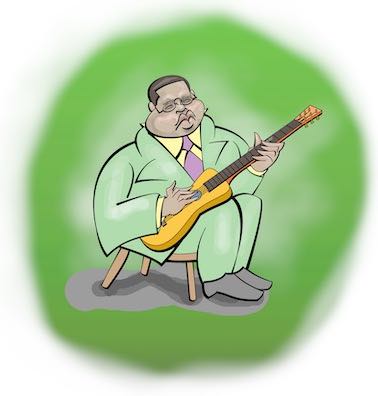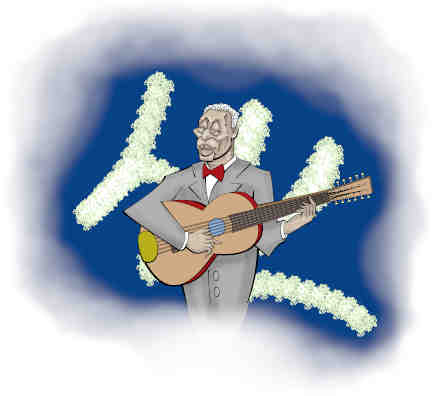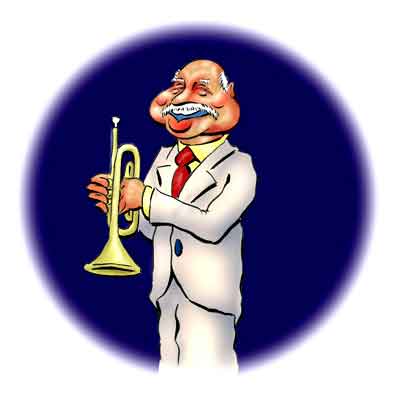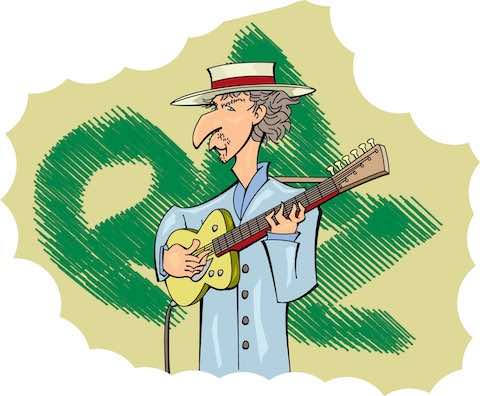Blind Lemon Jefferson

(Click to Zoom In and Out)
Blind Lemon Jefferson - and Lemon seems to have been his real name - was an early bluesman. Although he's not so famous to Joe and Josephine Blow on the street as are B. B. King or Muddy Waters, Lemon was one of the first blues singers to reach a national audience.
Lemon was born and grew up not far from Dallas. There in 1912, Lemon - only 19 - met a fellow musician only a few years older. That was Mr. Huddie Ledbetter, better known as Leadbelly. Huddie and Lemon teamed up and played at dances and on street corners. They didn't do all that bad and in one weekend, Huddie said they pulled in $150. In 1912, that was good dough1.
Footnote
Although people usually use the Consumer Price Index to equate cash values from the past to today, the CPI usually undercounts the money's real value.
For one thing, there was no income tax. So automatically add about 30% to any income. Also some activities that today are routine - like eating out - were luxuries and rare treats. So people spent less on food. Also what were fairly uniform costs have diverged, resulting in disproportionate changes in purchasing power for some items compared to others.
For instance, in 1912 meat prices tended to be not too far apart: 15¢ - 20¢ per pound. It didn't matter if you were talking about bacon, ham, fish, pork, or beef. But today the prices vary considerably and even depend somewhat irrationally on the "prestige" of the cut. Bacon hits between $4 - $6 a pound but a porterhouse roast is over $20. And you can find the Japanese steak wagyu for $200 to $400 a pound! So costs of some meats have risen by a factor of 30 and others by a factor of over a thousand!
Other items have gone up less. Butter - now about $3.70 a pound was selling for 37¢. Eggs were 40¢ a dozen and now you'll find them at about $4.00 for the twelve. In either case, a mere factor of 10.
So although the CPI Index gives a value of $150 in 1912 as about $4000 today, a more balanced and realistic equivalent would be something like $20,000.

Leadbelly
He and Lemon teamed up.
(Click image to zoom in and out.)
Lemon and Huddie traveled together for five years. Of course since Huddie made regular trips back to his folks' home near Mooringsport, Louisiana, this produced an intermittent itinerary for the musical partnership. It was also around 1915 that Huddie began to have, well, circumstances that harken back to Shakespeare's Othello:
| Othello: | Where will you that I go To answer this your charge? |
| Brabantio: | To prison, till fit time Of law and course of direct session Call thee to answer. |
Sure enough, in 1915 Huddie ended up getting sentenced for 30 days to the Harrison County, Texas, chain gang. He escaped after three days and lived on the lam under an assumed name. But there in 1917 he really had trouble with the Texas constabulary. The net result was that from 1918 to 1925 Huddie, as "Walter Boyd", was a resident of the State of Texas Correctional System as Prisoner 42738 imprisoned for murder.
It was during Huddie's hiatus that Lemon became famous. This unexpected rise from regional busker to national celebrity was assisted by a technology that burst forth in the formative decades of the Twentieth Century.
But first a biographical digression.
No one knows when Lemon was born, but scholarly consensus points to 1893 as most likely. His parents were farmers, living just a few miles south of Dallas. Lemon exhibited musical ability at an early age and was noted for his church singing.
Documents indicate that Lemon was blind from birth. Medically this is correct, but it's likely that he had more of what the layman would call severely impaired vision. Remember that many blind people do have some sight. According to the American Federation for the Blind, legal blindness is defined as having 20/200 vision as the best of correction or a visual field of 20 degrees or less.
Lemon did wear glasses of the corrective type, not just "shades" intended to physically protect the eyes from sunlight. His friends also remember him at times managing on his own. As a kid he would pitch pennies and navigate the neighborhood fairly well. On the other hand, he also would have a friend act as his "leader" when he would go from place to place.
It wasn't only by music that Lemon made a living. As a teenager - he was quite hefty and eventually neared 250 pounds - he found work as a professional wrestler. But that wasn't as nice as playing the guitar and singing. Once his music began bringing in income he abandoned the ring.
Given his roots no one is surprised to learn that Lemon is credited as a seminal innovator of what's called "Texas Blues". Texas Blues, as one popular information website mentions, is blues from Texas. A bit more scholarly definition is that the term refers to the style drawn chiefly on African American traditions but in an area where white country, Cajun, and Hispanic crossover musicians mixed in.
A factor in the formation of the regional style was the fact that the largest city, Dallas2 became a hub of the recording industry. Yes, yes, we know it isn't Nashville, but at that time not even Nashville was Nashville. But Dallas was a geographical focus of the South Central United States which made it convenient for the talent scouts from up North to descend.
Footnote
This comment may send the citizens of Houston into spittle-flinging diatribes. Yes, Houston is the larger city - today. But it didn't step ahead of Dallas until around 1925.
We said that technology was important in establishing Lemon's fame. The commercial recording industry had begun in the late 1880's which was only a decade after Tom Edison's invention. But due to the poor sound quality and the fragility of the recordings themselves, the business didn't really take off until around 1900. From then on you could hear celebrities like Enrico Caruso belting out their arias and even listen to famous composers like Brahms conducting their own music. Popular music of the day also sold well. You could sit back and have "Alexander's Ragtime Band", "Way Down Upon the Swanee River", or "A Bicycle Built for Two" wafting out in the comfort of your own home.

W. C. Handy
The First Blues
It took some doing to get jazz and blues sounding like it should. "The Memphis Blues" by W. C. Handy (who also wrote "The St. Louis Blues") was recorded in late 1914 by white singer Morton Harvey accompanied by an orchestra, probably all of whom had never heard authentic blues before. So what you get is a vaudeville pop tune that had a strangely operatic feel.
On the other hand when the "Livery Stable Blues" was released in 1917 by the Original Dixieland Jass Band (later the Original Dixieland JaZZ3 Band) the music was recognizably Dixieland. But the performers, all of whom were white and in a statement certainly intended to enhance the sales in a segregated society, denied (incorrectly) that jazz was of African origin.
Footnote
Why the two zee's were substituted for the two esses is the subject of much linguistic speculation. One hypothesis, which very well may be true, is that the musicians got tired of having their announcement posters subject to the "joke" where the "J" was crossed out.
The process of recording was an amazingly laborious one. You had to arrange the instruments so that there would be a good balance when the sound reached the "horn". Of course these early recordings were made in studios or even in engineering laboratories. What we call country music got off to a slow start since to record where the music was - then called "hillbilly music" - you needed portable equipment.
Although not actually the first country recording, the first country hit was Fiddling' John Carson's "Little Old Log Cabin In The Lane" and "The Old Hen Cackled and the Rooster's Going to Crow" on the flip side. The songs were recorded on June 14, 1923 in Atlanta.
The record was so bad that the production company, Okeh, didn't even put a serial number on it. But Polk Brockman, the businessman and record vendor who had arranged the session, said he'd buy 500 copies. He would sell them not only in his store but at music festivals and performances.
When Polk got the copies they sold out immediately and he ordered another 10,000. Ralph Peer, the head of Okeh, decided to bring Fiddlin' John up to New York where they could make a better recording. Yes, they did put a serial number on the disk and listed it in the catalog.
In 1923 recording was "acoustic". There was no electricity needed and all the equipment was mechanical. The first machines were powered by hand cranking of the cylinder but now the rpms of the turntable were controlled by a tension spring that slowly unwound. The drawback of acoustical recording was that no matter how sophisticated, the sound always seemed like it was coming from the bottom of a barrel.
But within two years, electric recording changed everything. Electrical equipment increased the volume, improved the balance, reduced the noise, and permitted "mixing" of the sound. You no longer had to laboriously arrange the musicians around the horn. Instead you just adjusted the placement of the microphones - far easier. If they are in good condition, recordings from 1925 rival modern quality. Even portable equipment - powered by large batteries - was electrified by the 1930's. Although quite bulky the machines were able to make records in almost any town and any place you could set the equipment up.
By the advent of the Roaring Twenties and even before electric recording, the potential market for records was outstripping the number of disks produced. So the executives were actively seeking out new talent and would send scouts throughout the country. They would literally scour the street corners looking for the next big star.
It was at this dawn of electric recording that a talent scout "discovered" Lemon. From 1925 to 1929 he made over 100 records. With his expert guitar playing and strong vocals, the platters sold well.
How much money did Lemon make? True, the $150 in one weekend was certainly not typical but Lemon always was able to wear a suit and tie. In later years he even hired a chauffeur to drive him around. So he must have done all right, and even before he began recording, he was able to marry and start a family.
As far as how much Lemon cleared in royalties, who knows? Probably not much. Most likely he was paid a flat session fee plus expenses. The thinking was that the musicians would prefer a substantial up-front payment rather get the money in dribbles and drabs as royalties.
But Lemon's fame undeniably brought him bookings, whether it was a formal concert in the prestigious Booker T. Washington Theater in St. Louis or playing for private "rent parties". Rent parties were gatherings where a resident of a house or an apartment would hire a musician or a band. The guests would chip in a certain fee with part going to the host to pay the rent and the rest to the musicians.
Lemon was in Chicago in December 1929 most likely to cut some more sides. The weather, though, was heavy snowfall and low temperatures. At some point - no one knows the exact date - Lemon's car was found abandoned on the side of the road. In a scene eerily foreshadowing the fate of Hank Williams, Sr., Lemon was inside, dead.
What happened no one knows. Speculation is he had a heart attack and his chauffeur simply panicked. Another possibility is the car broke own or got stuck in the snow and the chauffeur just left Lemon in the car and for some reason never returned.
A lot of singers have since recorded Blind Lemon's songs. "See That My Grave Is Kept Clean" is particularly popular.
Well, it's one kind favor I ask of you.
It's one kind favor I ask of you.
Yes, it's one kind favor that I'll ask of you.
See that my grave is kept clean.
It's a long old lane ain't got no end.
It's a long lane that's got no end.
It's a long lane that ain't got no end.
And it's a bad wind that never change.
It's two white horses in a line.
Yes, it's two white horses in a line.
Well, it's two white horses in a line.
Gonna take me to my burying ground.
My heart stopped beating, and my hands got cold.
My heart stopped beating, and my hands got cold.
Yes, my heart stopped beating, and my hands got cold.
It wasn't long before the service by the cypress grove.
Have you ever heard a coffin sound?
Have you ever heard a coffin sound?
Have you ever heard a coffin sound?
Well, you know that your poor boy is in the ground.
Oh, dig my grave with a silver spade.
Dig my grave with a silver spade.
Yes, dig my grave with a silver spade.
You may lead me down with a golden chain.
Have you ever heard a church bell tone?
Have you ever heard a church bell tone?
Have you ever heard a church bell tone?
Then you know that your poor boy is dead and gone.

Nobel Laureate
The poetry of the verses can't be denied. Why else would it have been recorded by the winner of the 2016 Nobel Prize in Literature?
References
"Jefferson, Blind Lemon", Alan Govenar, Handbook of Texas Online, Texas State Historical Society.
Deep Ellum: The Other Side of Dallas, Alan Govenar and Jay Brakefield, Texas A&M University Press, 2013.
Texas Blues: The Rise of a Contemporary Sound, Alan Govenar, Texas A&M University Press, 2008.
The Life And Legend Of Leadbelly, Charles Wolfe and Kip Lornell, HarperCollins, 1992, Da Capo Press, 1999,
"A Brief History of Recording to ca. 1950", Roger Beardsley and Daniel Leech-Wilkinson, AHRC Research Centre for the History and Analysis of Recorded Music (CHARM), King's College London, 2009.
"Fiddlin' John Carson", Bluegrass Messengers.
"The Site of Country Music’s First Recorded Hit Is Set to Be Demolished", Jason Daley, Smithsonian Magazine, May 9, 2019.
"The First Jazz Recording Was Made by a Group of White Guys?", John Edward Hasse, Smithsonian Magazine, February 24, 2017.
"The Mysterious Origins of Jazz", Christian Blauvelt, BBC, February 24, 2017.
Music from the True Vine: Mike Seeger's Life and Musical Journey, Bill Malone, University of North Carolina Press, 2011.
"Blind Lemon Jefferson", Joslyn Layne, AllMusic
"Bob Dylan, Lou Reed, Grateful Dead and More Cover Blind Lemon Jefferson", Egil Mosbron, Born to Listen.